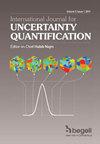PARALLEL PARTIAL EMULATION IN APPLICATIONS
IF 1.8
4区 工程技术
Q2 ENGINEERING, MULTIDISCIPLINARY
International Journal for Uncertainty Quantification
Pub Date : 2024-05-01
DOI:10.1615/int.j.uncertaintyquantification.2024048538
引用次数: 0
Abstract
Emulators are used to approximate the output of large computer simulations. Statistical emulators are surrogates that, in addition to predicting the mean behavior of the system, provide an estimate of the error in that prediction. Classical Gaussian Stochastic Process emulators predict scalar outputs based on a modest number of input parameters. To make predictions across a space-time field of input variables is not feasible using classical Gaussian process methods. Parallel Partial Emulation is a new statistical emulator methodology that predicts a field of outputs at space-time locations, based on a set of input parameters of modest dimension. Parallel partial emulation is constructed as a Gaussian process in parameter space, but no correlation in space/time is assumed. Thus the computational work of parallel partial emulation scales as the cube of the number of input parameters (as traditional Gaussian Process emulation) and linearly with space-time grid. The behavior of Parallel Partial Emulation predictions in complex applications is not well understood. Scientists would like to understand how predictions depend on the separation of input parameters, across the space-time outputs. It is also of interest to study whether the emulator predictions inherit properties (e.g conservation) from the numerical simulator. This paper studies the properties of emulator predictions, in the context of scalar and systems of partial differential equation.应用中的并行局部仿真
仿真器用于近似大型计算机仿真的输出。统计仿真器是一种代用工具,除了预测系统的平均行为外,还提供预测误差的估计值。并行局部仿真是一种新的统计仿真方法,它能根据一组维度适中的输入参数,预测时空位置的输出场。并行局部仿真在参数空间中构建为高斯过程,但不假定时空相关性。因此,并行局部仿真的计算工作量与输入参数数量的立方成比例(与传统的高斯过程仿真一样),与时空网格成线性比例。科学家们希望了解预测如何依赖于输入参数的分离以及跨时空的输出。研究仿真器预测是否继承了数值模拟器的特性(如守恒性)也很有意义。
本文章由计算机程序翻译,如有差异,请以英文原文为准。
求助全文
约1分钟内获得全文
求助全文
来源期刊

International Journal for Uncertainty Quantification
ENGINEERING, MULTIDISCIPLINARY-MATHEMATICS, INTERDISCIPLINARY APPLICATIONS
CiteScore
3.60
自引率
5.90%
发文量
28
期刊介绍:
The International Journal for Uncertainty Quantification disseminates information of permanent interest in the areas of analysis, modeling, design and control of complex systems in the presence of uncertainty. The journal seeks to emphasize methods that cross stochastic analysis, statistical modeling and scientific computing. Systems of interest are governed by differential equations possibly with multiscale features. Topics of particular interest include representation of uncertainty, propagation of uncertainty across scales, resolving the curse of dimensionality, long-time integration for stochastic PDEs, data-driven approaches for constructing stochastic models, validation, verification and uncertainty quantification for predictive computational science, and visualization of uncertainty in high-dimensional spaces. Bayesian computation and machine learning techniques are also of interest for example in the context of stochastic multiscale systems, for model selection/classification, and decision making. Reports addressing the dynamic coupling of modern experiments and modeling approaches towards predictive science are particularly encouraged. Applications of uncertainty quantification in all areas of physical and biological sciences are appropriate.
 求助内容:
求助内容: 应助结果提醒方式:
应助结果提醒方式:


